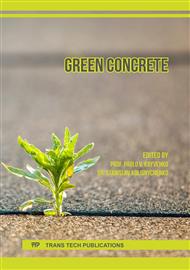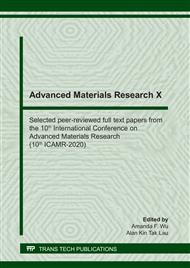[1]
Sengul, O. and Tasdemir, M.A., Compressive strength and rapid chloride permeability of concretes with ground fly ash and slag,, Journal of Materials in Civil Engineering, 21, 2009, pp.494-501.
DOI: 10.1061/(asce)0899-1561(2009)21:9(494)
Google Scholar
[2]
Radlinski, M. & Olek, J., (2015). Effects of Curing Conditions on the Properties of Ternary (Ordinary Portland Cement/Fly Ash/Silica Fume) Concrete. Materials Journal, 112(1), 49-58.
DOI: 10.14359/51687307
Google Scholar
[3]
Reddy, M. and Ashalatha, K., Significant role of Supplementary Cementing Materials in Concrete for the Assessment of Durability,, Research Journal Engineering and Technology, 8(3), 2017, pp.187-190.
DOI: 10.5958/2321-581x.2017.00030.7
Google Scholar
[4]
Dalvand, A., Sharbatdar, M.K., Kheyroddin, A. and Nikui, A., Assessment of statistical variations in experimental impact resistance and mechanical properties of silica fume concrete,, Scientia Iranica A, 21(5), 2014, pp.1577-1590.
Google Scholar
[5]
Sabouni, R., & Abdulhameed, H. R. (2019). Investigation on Performance of Concrete Incorporating Silica Fume and Local UAE Materials. Key Engineering Materials, 803, 222–227.
DOI: 10.4028/www.scientific.net/kem.803.222
Google Scholar
[6]
Wang, F. and Li, S., Effect of Silica Fume on Workability and Water Impermeability of Concrete,, Applied Mechanics and Materials, 238, 2012, pp.157-160.
DOI: 10.4028/www.scientific.net/amm.238.157
Google Scholar
[7]
Wang, Q. and Bao, J, Effect of Silica Fume on Mechanical Properties and Carbonation Resistance of Concrete,, Applied Mechanics and Materials, 238, 2012, pp.161-164.
DOI: 10.4028/www.scientific.net/amm.238.161
Google Scholar
[8]
Sabouni, R. and Al Hosani, Y., Effect of sulfate attack on compressive strength of concrete in UAE,, Proceeding 9th Symposium on High Performance Concrete, Rotorua, New Zealand, 2011, pp.36-43.
Google Scholar
[9]
Sabouni, R., Al Musabi, S. and Sulaiman S.G.D., Effect of Admixtures Dosage on Sulfate Attack of Concrete with Slag and Microsilica,, Proceeding, 2nd International Conference on Future Concrete, Dubai, UAE, 2011, pp.1-9.
Google Scholar
[10]
Sabouni, R. and Abdulhameed, H., The Mechanical Properties and durability of High Strength Concrete with fly ash Incorporating UAE Local Materials", Proceeding of the ConMat,15 conference, Whistler, Canada, (2015).
Google Scholar
[11]
Quan, H.Z., & Kasami, H. (2014). Experimental Study on Durability Improvement of Fly Ash Concrete with Durability Improving Admixture. The Scientific World Journal, 2014(Article ID 818103), 11 pages, http://dx.doi.org/10.1155/2014/818103.
DOI: 10.1155/2014/818103
Google Scholar
[12]
Liu, Y., & Presuel-Moreno, F. (2014). Effect of Elevated Temperature Curing on Compressive Strength and Electrical Resistivity of Concrete with Fly Ash and GGBS. Materials Journal, 111(5), 531-542.
Google Scholar
[13]
Bouzoubaa, N., Bilodeau, A., Tamtsia, B., & Foo, S. (2010). Carbonation of fly ash concrete: laboratory and field data. Canadian Journal of Civil Engineering, 37, 1535-1549.
DOI: 10.1139/l10-081
Google Scholar
[14]
Padmanaban, I., Kandasamy, S., & Natesan, S. C. (2009). Statistical modeling of high and low volume of fly ash high compressive strength concrete. International Journal of Applied Engineering Research, 4(7), 1161-1167.
Google Scholar
[15]
Kazberuk, M.K., & Lelusz, M. (2007). Strenght development of concrete with fly ash addition. Journal of Civil Engineering and Management, XIII(2), 115-122.
DOI: 10.3846/13923730.2007.9636427
Google Scholar
[16]
Sabouni, R. (2011). Durability of Concrete Structures in Arabian Gulf: State of the Art and Improved Scheme,, ALHOSN University Journal of Engineering and Applied Sciences, Vol. 3, No. 2, pp.73-89.
Google Scholar
[17]
Al-Shaibani Afrah and Sabouni, R. (2016). Sustainability Considerations of Concrete Mixes Incorporating Slag as Partial Replacement of Cement in Concrete in the UAE,, Key Engineering Materials, Vol. 677, pp.217-223.
DOI: 10.4028/www.scientific.net/kem.677.217
Google Scholar
[18]
Abu Dhabi Urban Planning Council (2010) The Pearl Rating System for Estidama Building Rating System: Design & Construction (Version 1.0),http://estidama.upc.gov.ae/template/estidama/docs/PBRS%20Version%201.0.pdf.
DOI: 10.1016/j.renene.2014.08.018
Google Scholar
[19]
Sengul, O., Tasdemir, C., and Tasdemir, M. A. (2005) Mechanical properties and rapidchloride permeabilites of concretes with ground fly ash., ACI Material Journal, 102:6, p.414–421.
Google Scholar



